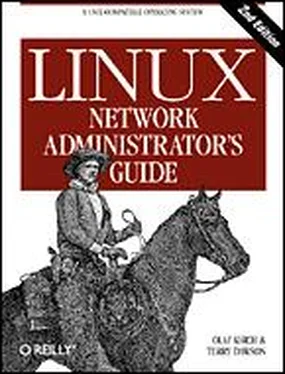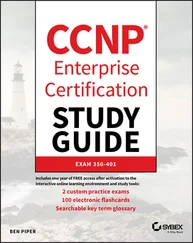For some maps, people commonly use nicknames , which are shorter and therefore easier to type. Note that these nicknames are understood only by ypcat and ypmatch, two tools for checking your NIS configuration. To obtain a full list of nicknames understood by these tools, run the following command:
$ ypcat -x
Use "passwd" for "passwd.byname"
Use "group" for "group.byname"
Use "networks" for "networks.byaddr"
Use "hosts" for "hosts.byaddr"
Use "protocols" for "protocols.bynumber"
Use "services" for "services.byname"
Use "aliases" for "mail.aliases"
Use "ethers" for "ethers.byname"
The NIS server program is traditionally called ypserv. For an average network, a single server usually suffices; large networks may choose to run several of these on different machines and different segments of the network to relieve the load on the server machines and routers. These servers are synchronized by making one of them the master server , and the others slave servers . Maps are created only on the master server's host. From there, they are distributed to all slaves.
We have been talking very vaguely about "networks." There's a distinctive term in NIS that refers to a collection of all hosts that share part of their system configuration data through NIS: the NIS domain . Unfortunately, NIS domains have absolutely nothing in common with the domains we encountered in DNS. To avoid any ambiguity throughout this chapter, we will therefore always specify which type of domain we mean.
NIS domains have a purely administrative function. They are mostly invisible to users, except for the sharing of passwords between all machines in the domain. Therefore, the name given to an NIS domain is relevant only to the administrators. Usually, any name will do, as long as it is different from any other NIS domain name on your local network. For instance, the administrator at the Virtual Brewery may choose to create two NIS domains, one for the Brewery itself, and one for the Winery, which she names brewery and winery respectively. Another quite common scheme is to simply use the DNS domain name for NIS as well.
To set and display the NIS domain name of your host, you can use the domainname command. When invoked without any argument, it prints the current NIS domain name; to set the domain name, you must become the superuser:
# domainname brewery
NIS domains determine which NIS server an application will query. For instance, the login program on a host at the Winery should, of course, query only the Winery's NIS server (or one of them, if there are several) for a user's password information, while an application on a Brewery host should stick with the Brewery's server.
One mystery now remains to be solved: how does a client find out which server to connect to? The simplest approach would use a configuration file that names the host on which to find the server. However, this approach is rather inflexible because it doesn't allow clients to use different servers (from the same domain, of course) depending on their availability. Therefore, NIS implementations rely on a special daemon called ypbind to detect a suitable NIS server in their NIS domain. Before performing any NIS queries, an application first finds out from ypbind which server to use.
ypbind probes for servers by broadcasting to the local IP network; the first to respond is assumed to be the fastest one and is used in all subsequent NIS queries. After a certain interval has elapsed, or if the server becomes unavailable, ypbind probes for active servers again.
Dynamic binding is useful only when your network provides more than one NIS server. Dynamic binding also introduces a security problem. ypbind blindly believes whoever answers, whether it be a humble NIS server or a malicious intruder. Needless to say, this becomes especially troublesome if you manage your password databases over NIS. To guard against this, the Linux ypbind program provides you with the option of probing the local network to find the local NIS server, or configuring the NIS server hostname in a configuration file.
NIS and NIS+ share little more than their name and a common goal. NIS+ is structured entirely differently from NIS. Instead of a flat namespace with disjoint NIS domains, NIS+ uses a hierarchical namespace similar to that of DNS. Instead of maps, so-called tables are used that are made up of rows and columns, in which each row represents an object in the NIS+ database and the columns cover properties of the objects that NIS+ knows and cares about. Each table for a given NIS+ domain comprises those of its parent domains. In addition, an entry in a table may contain a link to another table. These features make it possible to structure information in many ways.
NIS+ additionally supports secure and encrypted RPC, which helps greatly to solve the security problems of NIS.
Traditional NIS has an RPC Version number of 2, while NIS+ is Version 3. At the time we're writing, there isn't yet a good working implementation of NIS+ for Linux, so it isn't covered here.
If you are familiar with writing or porting network applications, you may notice that most of the NIS maps listed previously correspond to library functions in the C library. For instance, to obtain passwd information, you generally use the getpwnam and getpwuid functions, which return the account information associated with the given username or numerical user ID, respectively. Under normal circumstances, these functions perform the requested lookup on the standard file, such as /etc/passwd .
An NIS-aware implementation of these functions, however, modifies this behavior and places an RPC call to the NIS server, which looks up the username or user ID. This happens transparently to the application. The function may treat the NIS data as though it has been appended to the original passwd file so both sets of information are available to the application and used, or as though it has completely replaced it so that the information in the local passwd is ignored and only the NIS data is used.
For traditional NIS implementations, there were certain conventions for which maps were replaced and which were appended to the original information. Some, like the passwd maps, required kludgy modifications of the passwd file which, when done incorrectly, would open up security holes. To avoid these pitfalls, NYS and the GNU libc use a general configuration scheme that determines whether a particular set of client functions uses the original files, NIS, or NIS+, and in which order. This scheme will be described later in this chapter.
After so much theoretical techno-babble, it's time to get our hands dirty with actual configuration work. In this section, we will cover the configuration of an NIS server. If an NIS server is running on your network, you won't have to set up your own; in this case, you may safely skip this section.
Note that if you are just going to experiment with the server, make sure you don't set it up for an NIS domain name that is already in use on your network. This may disrupt the entire network service and make a lot of people very unhappy and very angry.
There are two possible NIS server configurations: master and slave. The slave configuration provides a live backup machine, should your master server fail. We will cover the configuration only for a master server here. The server documentation will explain the differences, should you wish to configure a slave server.
Читать дальше



![Andrew Radford - Linguistics An Introduction [Second Edition]](/books/397851/andrew-radford-linguistics-an-introduction-second-thumb.webp)








